Growing your own avocado tree can be a fun and, actually, also a very rewarding idea, even if you only have a small space.
I’ve seen people growing avocado trees both in an apartment and a house with a yard, since it’s possible to cultivate them in a container.
Is it simple? Well, the process is quite straightforward and beginner-friendly. The difficult part is getting nice avocado pears. Having a fruitful harvest is easier if you have land and space, but you can still get great results in pots if you know what you’re doing.
In this guide, we’ll walk you through seven simple steps to plant, grow, and care for an avocado tree in a pot. Make sure to follow every step carefully!
Choose the Right Avocado and Pot
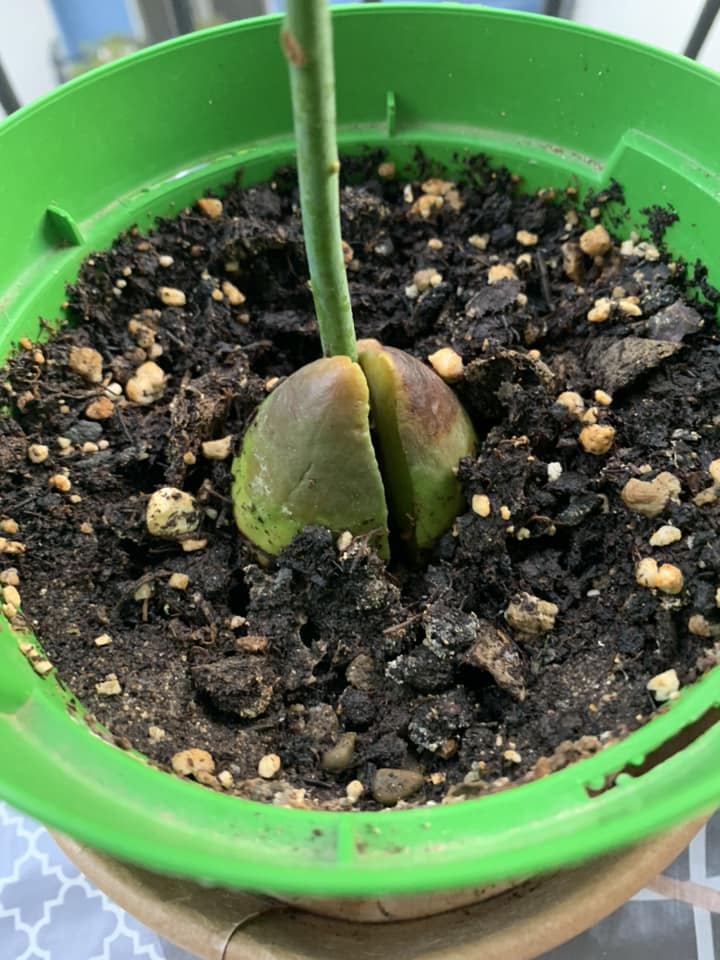
The first important thing is to pick a suitable avocado variety. Consider that for container growing, dwarf or compact varieties are ideal.
Standard avocado trees can reach 30-80 feet tall, which is far too large for a pot, and you should only choose it if you have a very big garden.
Talking about small varieties, a good choice could be the Wurtz (also called “Little Cado”), which is the only true dwarf avocado, maxing out around 10 to 15 feet tall. It’s famous for being compact, self-fertile, and perfect for small spaces.
Another good alternative could be the Hass variety (the most common in stores), which isn’t dwarf, but it can be grown in a container with regular pruning, just know it may become a large tree over time.
The third choice is the Lamb Hass. It’s basically a semi-dwarf hybrid (a cross between Hass and a dwarf variety, Gwen) that grows more upright and compact (about 25′ tall at maturity); therefore, it’s quite a popular choice for pots.
PRO TIP: As we’ve seen, there are several varieties of small avocados. If you are not sure, ask an expert at the store.
The other crucial choice is the container. Start with a small pot for a young seed or seedling, usually about 6 to 8 inches in diameter is a good starting size.
Ensure the pot has plenty of drainage holes, because avocados hate sitting in water. As your tree grows, you will “pot up” (transfer it to larger pots) over time. For healthy growth, a mature potted avocado will need a large container, roughly 15 to 20 gallons in size, to accommodate its roots.
Many gardeners use a pot about 24 inches wide or even a half wine barrel for a mature dwarf avocado, and that also can definitely be a good option. So once again, the rule is to start small and gradually move to bigger pots as the plant outgrows its container. If you have it, prefer a terra cotta pot because it’s porous and provides good aeration and drainage for the roots.
Sprout Your Avocado Seed
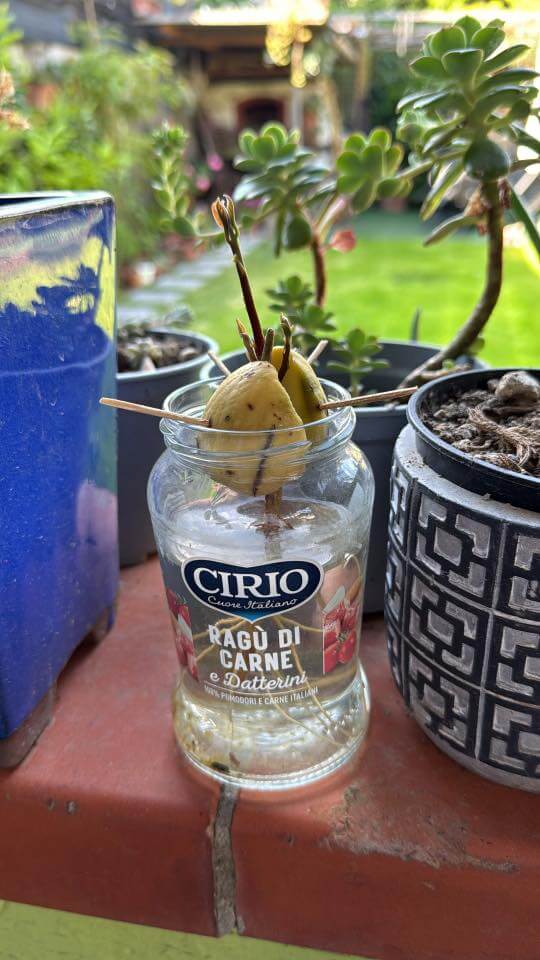
If you’re starting from a seed (pit), the first step is to germinate it. This is a fun and easy process, but you have to pay attention to the details.
The first thing you have to do is to remove and clean the pit. After enjoying your avocado, take out the large seed and rinse off any fruit residue. For best results, use a fresh pit (you don’t have to let it dry out for days).
The soaking part in this case is optional. Some gardeners like to soak the seed in water overnight to soften the outer brown husk and boost germination. I usually do it because I believe it can help the seed sprout faster.
In particular, I’ve used the traditional method of suspending the seed in water. Just insert 3 or 4 toothpicks into the sides of the pit, about halfway up the seed, spaced evenly. The toothpicks act as a support so you can set the pit halfway into a glass of water. Make sure the broad end of the seed is down in the water, and about one-third of the seed remains above the water. The pointed end should be on top.
Put your jar with the avocado seed on a windowsill or another spot with bright light but not direct scorching sun. For example, near an east or west-facing window is great. Check the water level to keep the bottom of the seed submerged and refresh the water every week or so to prevent mold or slime.
Keep in mind that avocado seeds can be slow to germinate, so be patient. In about 2 to 6 weeks, you should see the seed begin to split and a root emerging from the bottom. Soon after, a little stem will peek out of the top. (If nothing happens after 2 months, something is wrong, so just try with another seed.)
If you decide to buy a young dwarf avocado tree instead of sprouting a seed, you can skip the toothpick stage. Your small tree will likely come in a nursery pot. Just ensure you have a suitable container and fresh potting mix ready to transplant it (we’ll cover potting next). The advantage of a grafted nursery tree is that it can produce fruit much sooner (often in a couple of years) compared to a seed-grown tree, which might take more years to fruit.
Plant the Avocado in a Pot
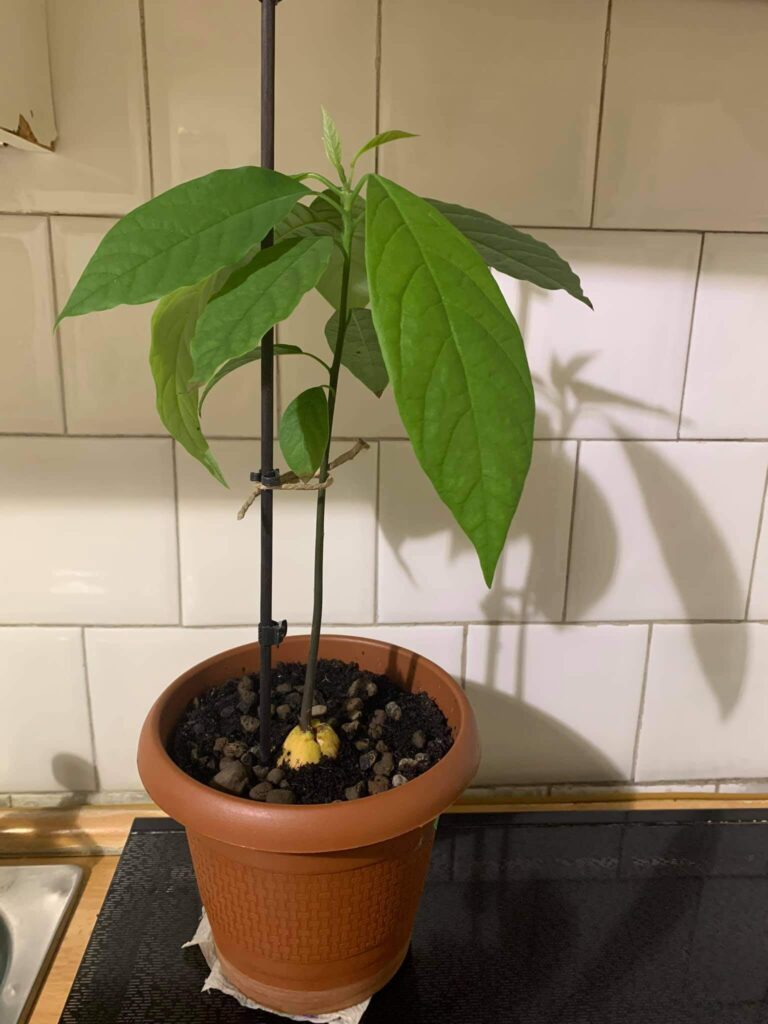
Once your avocado pit has sprouted roots (around 3-6 inches long) and a stem with a couple of leaves, it’s time to transfer it to a pot. If you bought a small tree, you’ll also be potting it up now.
The first thing to do is to fill your pot (6-8 inch diameter for starters) with a good quality, well-draining potting mix. Avocado roots need lots of air, so remember that drainage is critical to prevent root.
A standard potting soil mixed with coarse sand or perlite works well. For example, you can use a mix that contains components like sandy loam, perlite, or pumice to ensure water doesn’t linger around the roots. In addition, if you have compost, mixing a bit in can provide nutrients, but make sure the overall mix is loose and fast-draining.
PRO TIP: Avoid using heavy garden soil in a pot, as it can become compacted and waterlogged. And always ensure the pot’s drainage holes are clear.
After that, just gently remove the toothpicks and place the sprouted seed in the soil. Position it so that the top of the seed stays slightly above the soil line, and the roots are buried. In other words, cover the roots and the bottom part of the pit with soil, but leave the top part of the seed peeking out.
If you’re planting a young tree from a pot, transplant it to the new container at the same soil depth it was in its nursery pot (don’t bury the stem deeper than it was). Firm the soil around the pit or root ball gently to eliminate big air pockets.
After planting, give the soil a good drink of water until it drains out the bottom holes. This helps settle the soil around the roots. Avocados like moisture, so you want the soil to be evenly moist but not soggy.
Find the Right Spot
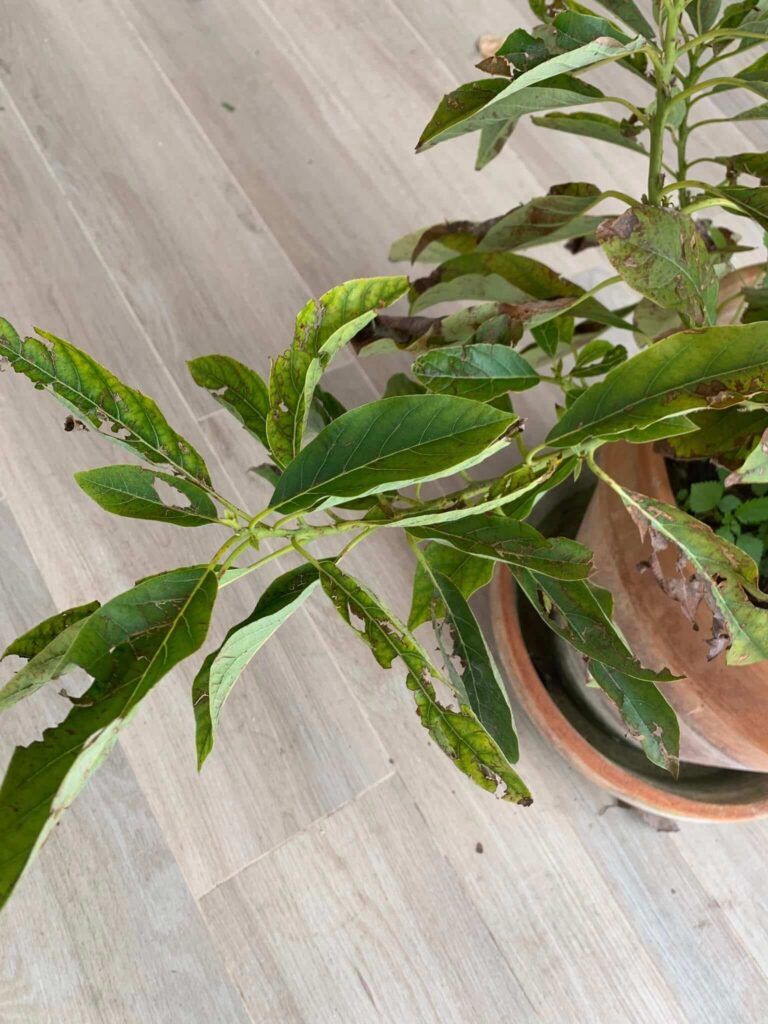
Avocado trees are sun-loving plants, but young seedlings can be a bit delicate with harsh sun, therefore striking the right balance of light is essential.
If you are keeping the plant indoors, place it near a sunny window where it gets plenty of bright, indirect light. A south or west-facing window is ideal. Avocado plants prefer at least 6 hours of light per day. If direct sunlight comes in, that’s fine for a mature plant, but try to avoid intense midday sun on a very young seedling with no canopy of leaves yet.
If you plan to grow your avocado outside (on a deck, balcony, or yard), give it some filtered sun or partial shade in the beginning. One again, young avocado plants can easily get sunburn on their stems if abruptly placed in all-day full sun.
A good approach is to put the pot in a spot that gets morning sun and afternoon shade, or dappled sunlight through a tree or shade cloth. After a few months, once the tree has more leaves and is stronger, it can gradually be moved to full sun.
As you probably already know, avocados like warmth, and their ideal growing temperature range is roughly 60-85°F. They do not tolerate frost or cold drafts well. If your plant is indoors, keep it away from cold windows or air conditioner drafts.
Watering and Feeding
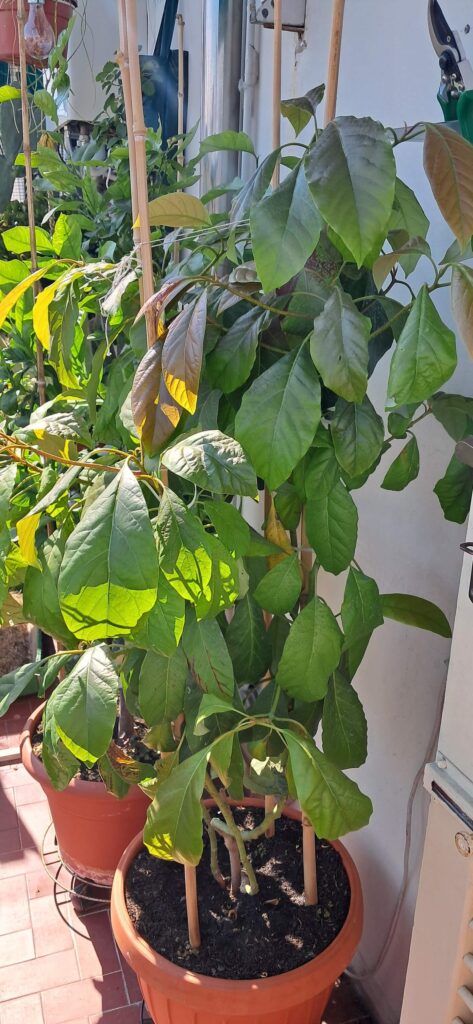
Getting the watering right is one of the most important parts of avocado care. As I’ve said many times now, avocado trees like moisture but hate having wet roots. The key is to water thoroughly, then let the top of the soil dry out slightly before the next watering.
In practice, this means that you have to check the solid frequently. Stick your finger about an inch into it, and if the top inch feels dry, it’s time to water. If it still feels damp, wait a bit longer. Overwatering is a common mistake; if you’re watering too much, you’ll probably start seeing yellow leaves.
To avoid errors, also remember to have a look at the most commont watering mistakes every gardener should avoid.
Apart from water, potted avocado trees also benefit from a little feeding, since they can exhaust nutrients in the potting mix over time.
The best thing you can do is to use a balanced, water-soluble fertilizer during the active growing season (spring and summer). An example formulation might be something like 7-9-5 N-P-K ratio, which provides more phosphorus for root and bloom support.
You can feed lightly once a month or according to your fertilizer’s instructions. Do not over-fertilize, too much can burn the roots or cause salt build-up (if you ever see a white crust on the soil, flush the pot with clean water to leach out salts). Also, remember that young avocado plants don’t need heavy feeding. In the first few months, if you used fresh potting soil, it likely has some nutrients already. Start fertilizing lightly after you see a flush of new growth, or about 3-4 months after planting.
Indoor/Outdoor Tips and Climate Considerations

One of the great advantages of growing an avocado in a pot is that you can move it to protect it from bad weather. Avocado trees are tropical/subtropical plants and are sensitive to cold.
If you live in the US, consider that avocados thrive outdoors year-round in places like coastal Southern California, South Florida, parts of Texas, and other mild-winter areas. If you live in these zones, you can keep the tree outside, but still be prepared to protect it from rare frost. I
In cooler regions or countries, you must bring the avocado indoors for winter or whenever frost is expected. In general, once night temperatures are consistently above 50°F, you can move your potted avocado outside to a sunny spot for the summer. This boost of sunlight and fresh air can spur lots of growth. Just remember to transition it gradually so it doesn’t get sunburned or shocked.
Pruning and Ongoing Care
When your avocado tree is growing, it’s time to think about long-term care. This includes pruning to manage its size and shape, repotting as it grows, and general maintenance.
The first thing to consider is that avocado trees can grow tall and lanky if left alone, especially indoors. To keep your potted avocado compact and bushy, do some pruning and pinching.
A good rule of thumb: when your plant reaches about 12 inches tall, pinch or trim off the top 2-3 inches of the stem. This encourages the plant to branch out and grow side shoots, rather than just one tall stalk. It might feel hard to cut your baby plant, but this will result in a fuller, more attractive tree.
Also trim any “suckers” that may shoot up from the base (especially if you have a grafted tree), those suckers from the rootstock won’t produce fruit and just steal energy. The best time to do a heavier prune is in early spring or right after any flowering cycle (for older trees), so you don’t accidentally cut off future flower buds. As usual, always use clean, sharp pruning shears to make neat cuts.
In addition, as your tree grows taller, the trunk might be thin. It’s a good idea to use a stake to support the main stem in the pot, especially in the first couple of years. Gently tie the stem to a bamboo stake or similar to keep it upright.
Also, remember that a young avocado plant will outgrow its pot relatively quickly. Plan to repot your tree about once a year in the spring for the first few years. Move it up to the next pot size each time (for example, from an 8-inch pot to a 12-inch, then to a 16-inch, etc.). Once you get to a very large container (15+ gallons), you won’t need to repot annually, but about every 2-3 years.
Please don’t be lazy in that, repotting is essential to give the roots more room and fresh soil. If you ever see roots growing out of the drainage holes or circling the surface, that’s a sign it’s root-bound and needs a bigger pot.
I hope you find this guide helpful and may your avocado tree bring you joy (and maybe even avocados) in the years to come!

